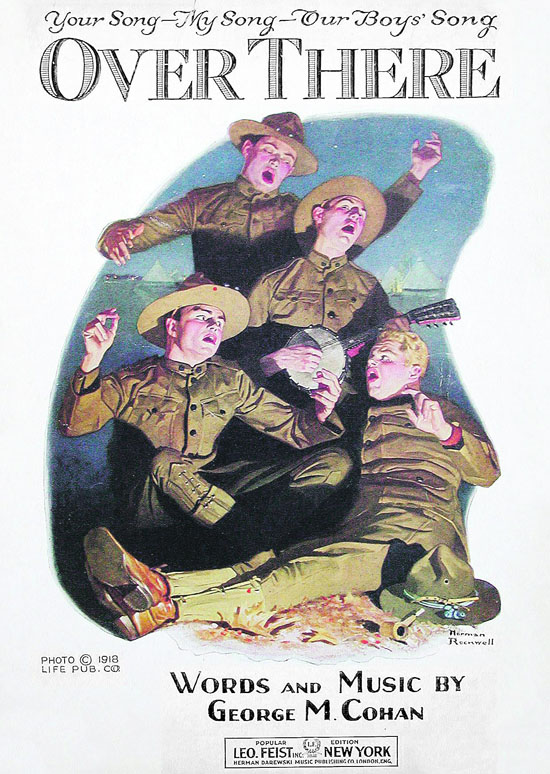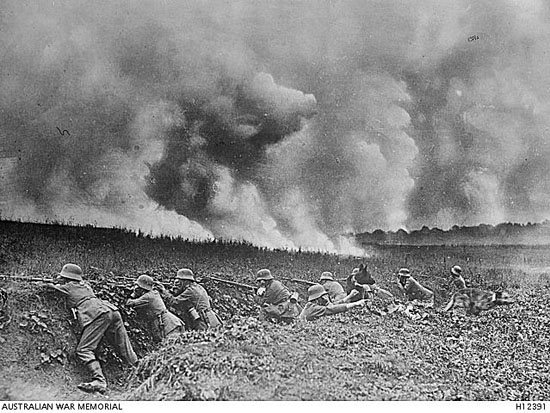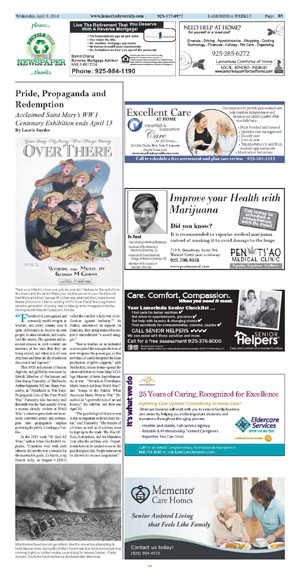|
|
Published April 9th, 2014
|
Pride, Propaganda and Redemption
|
| Acclaimed Saint Mary's WW I Centenary Exhibition ends April 13 |
| By Laurie Snyder |
 |
| "Pack your little kit, show your grit, do your bit / Yankees to the ranks from the towns and the tanks/ Make your mother proud of you / And the old Red White and Blue." George M. Cohan was awarded the Congressional Medal of Honor in 1936 for writing 1917's "Over There," the song that inspired a generation of young men to take up arms. Image provided by Hollingsworth Fine Art Collection, Florida. |
"Falsehood is a recognized and extremely useful weapon in warfare, and every country uses it quite deliberately to deceive its own people, to attract neutrals, and to mislead the enemy. The ignorant and innocent masses in each country are unaware at the time that they are being misled, and when it is all over only here and there are the falsehoods discovered and exposed."
 This 1928 indictment of human duplicity and gullibility was made by British Member of Parliament and first Baron Ponsonby of Shulbrede, Arthur Augustus William Harry Ponsonby, in "Falsehood in War-Time: Propaganda Lies of the First World War." Ponsonby also famously said that truth was the first casualty of war, a maxim already evident at World War I's outset as presidents and monarchs converted music and newspapers into propaganda engines powering the public's backing of battles.
This 1928 indictment of human duplicity and gullibility was made by British Member of Parliament and first Baron Ponsonby of Shulbrede, Arthur Augustus William Harry Ponsonby, in "Falsehood in War-Time: Propaganda Lies of the First World War." Ponsonby also famously said that truth was the first casualty of war, a maxim already evident at World War I's outset as presidents and monarchs converted music and newspapers into propaganda engines powering the public's backing of battles.
 In the 2011 book "To End All Wars," author Adam Hochschild explains, "Countries vied with each other to declare the war a crusade for the most noble goals. Le Matin, a big French daily, on August 4 [1914] called the conflict 'a holy war of civilization against barbarity.'" As Turkey announced its support for Germany, their sultan termed his empire's enmeshment "a sacred struggle."
In the 2011 book "To End All Wars," author Adam Hochschild explains, "Countries vied with each other to declare the war a crusade for the most noble goals. Le Matin, a big French daily, on August 4 [1914] called the conflict 'a holy war of civilization against barbarity.'" As Turkey announced its support for Germany, their sultan termed his empire's enmeshment "a sacred struggle."
 "Just as warfare on an industrial scale required the mass production of new weapons like poison gas, so this new kind of conflict required the mass production of public support," adds Hochschild, whose lecture opened the latest exhibition by Saint Mary's College Museum of Art to depict humanity at war - "Swords to Plowshares: Metal Trench Art from World War I" and "Songs of the Patriot: When American Music Went to War." Described as "a powerful mix of art and history," the exhibits end their run April 13.
"Just as warfare on an industrial scale required the mass production of new weapons like poison gas, so this new kind of conflict required the mass production of public support," adds Hochschild, whose lecture opened the latest exhibition by Saint Mary's College Museum of Art to depict humanity at war - "Swords to Plowshares: Metal Trench Art from World War I" and "Songs of the Patriot: When American Music Went to War." Described as "a powerful mix of art and history," the exhibits end their run April 13.
 "The psychological factor in war is just as important as the military factor," said Ponsonby. "The morale of civilians, as well as of soldiers, must be kept up to the mark. The War Offices, Admiralties, and Air Ministries look after the military side. Departments have to be created to see to the psychological side. People must never be allowed to become despondent."
"The psychological factor in war is just as important as the military factor," said Ponsonby. "The morale of civilians, as well as of soldiers, must be kept up to the mark. The War Offices, Admiralties, and Air Ministries look after the military side. Departments have to be created to see to the psychological side. People must never be allowed to become despondent."

|
 |
| Infantrymen faced poison gas attacks like this one while attempting to hold German lines during World War I trench warfare. Note messenger dog running (right) as soldier readies second dog for release (center). Public domain, Deutsche Reichsarchiv via Australian War Memorial. |
|
|
|
|
|
|
 |
|
|
|
|





